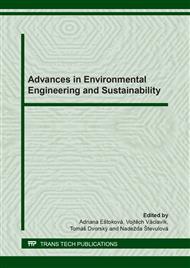[1]
European Parliament and European Council, 2018. Directive (EU) 2018/851 of the European Parliament and of the Council of 30 May 2018 amending Directive 2008/98/EC on waste.
DOI: 10.1007/978-1-137-54482-7_38
Google Scholar
[2]
N. Stevulova, K. Baltakys, A. Estokova, T. Sverak, Sustainable building materials and technologies 2018, Adv. Mater. Sci. Eng. 2018 (2018).
DOI: 10.1155/2018/9491813
Google Scholar
[3]
V. Hospodarova, N. Stevulova, J. Briancin, K. Kostelanska, Investigation of waste paper cellulosic fibers utilization into cement based building materials, Build. 8 (2018) 43.
DOI: 10.3390/buildings8030043
Google Scholar
[4]
M. Ondova, N. Stevulova, E. Zelenakova, Energy savings and environmental benefits of fly ash utilization as partial cement replacement in the process of pavement building, Chem. Eng. Trans. 25 (2011) 297–302.
Google Scholar
[5]
M. Ondova, N. Stevulova, Benefits of fly ash utilization in concrete road cover, Theor. Found. Chem. Eng. 46 (2012) 713–718.
DOI: 10.1134/s0040579512060176
Google Scholar
[6]
D.V. Bompa, A.Y. Elghazouli, B. Xu, P.J. Stafford, A.M. Ruiz-Teran, Experimental assessment and constitutive modeling of rubberised concrete materials, Constr. Build. Mater. 137 (2017) 246–260.
DOI: 10.1016/j.conbuildmat.2017.01.086
Google Scholar
[7]
D. Xuan, B. Zhan, C.S. Poon and W. Zheng, Innovative reuse of concrete slurry waste from ready-mixed concrete plants in construction products, J. Hazar. Mat. 312 (2016) 65-67.
DOI: 10.1016/j.jhazmat.2016.03.036
Google Scholar
[8]
M. Audo, P.Y. Mahieux, P. Turcy, L. Chateau, C. Churlaud, Characterization of ready-mixed concrete plants sludge and incorporation into mortars: Origin of pollutants, environmental characterization and impacts on mortars characteristics, J. Cle. Pro. 183 (2018) 153-161.
DOI: 10.1016/j.jclepro.2018.02.155
Google Scholar
[9]
A. Kazaz, S. Ulubeyli, Current Methods for the Utilization of the Fresh Conrete Waste Returned to Batching Plants, Pro. Eng. 161 (2016) 42-46.
DOI: 10.1016/j.proeng.2016.08.495
Google Scholar
[10]
B. Chatveera, P. Lertwattanaruk, N. Makul, Effect of sludge water from ready-mixed concrete plant on properties and durability of concrete, Cem. Concr. Comp. 28 (2006) 441-450.
DOI: 10.1016/j.cemconcomp.2006.01.001
Google Scholar
[11]
I.B. Topcu, The properties of rubberized concretes, Cem. Conr. Comp. 25 (1995) 304-310.
Google Scholar
[12]
A. Moustafa, M.A. ElGawady, Mechanical properties of high strenght concrete with scrap tire rubber, Constr. Build. Mat. 93 (2015) 249-256.
DOI: 10.1016/j.conbuildmat.2015.05.115
Google Scholar
[13]
A.J. Kardos, S.A. Durham, Strength, durability, and environmental properties of concrete utilizing recycled tire particles for pavement applications, Constr. Build. Mat. 98 (2015) 832-845.
DOI: 10.1016/j.conbuildmat.2015.08.065
Google Scholar
[14]
G. Girskas, D. Nagrockiene, Crushed rubber waste impact of concrete basic properties, Constr. Build. Mat. 140 (2017) 36-42.
DOI: 10.1016/j.conbuildmat.2017.02.107
Google Scholar
[15]
J. Wang, Q. Dai, R. Si, S. Guo, Mechanical, durability, and microstructural properties of macro synthetic polypropylene (PP) fiber-reinforced rubber concrete, J. Cle. Pro. 234 (2019) 1351-1364.
DOI: 10.1016/j.jclepro.2019.06.272
Google Scholar
[16]
F. Sandrolini, E. Franzoni, Waste wash water recycling in ready-mixed concrete plants, Cem. Conr. Comp 31 (2001) 485-489.
DOI: 10.1016/s0008-8846(00)00468-3
Google Scholar
[17]
G. Asadollahfardi, M. Asadi, H. Jafari, A. Moradi, R. Asadollahfardi, Experimental and statistical studies of using wash water from ready-mix concrete trucks and a batching plant in the production of fresh concrete, Con. Build. Mat. 98 (2015) 305-314.
DOI: 10.1016/j.conbuildmat.2015.08.053
Google Scholar
[18]
ČSN EN 197-1 Cement - Part 1: Composition, specifications and conformity criteria for common cementse. ÚNMZ, Prague, (2012).
Google Scholar
[19]
ČSN EN 1008 Mixing water for concrete - Specification for sampling, testing and assessing the suitability of water, including water recovered from processes in the concrete industry, as mixing water for concrete. ÚNMZ, Prague, (2003).
DOI: 10.3403/02609198
Google Scholar
[20]
ČSN EN 933-1 Tests for geometrical properties of aggregates - Part 1: Determination of particle size distribution - Sieving method. ÚNMZ, Prague, (2012).
DOI: 10.3403/01236185
Google Scholar
[21]
ČSN EN 1015-3 Methods of test for mortar for masonry - Part 3: Determination of consistence of fresh mortar. ÚNMZ, Prague, (2000).
DOI: 10.3403/01541440
Google Scholar
[22]
ČSN EN 196-1 Methods of testing cement - Part 1: Determination of strength. ÚNMZ, Prague, (2016).
Google Scholar
[23]
ČSN EN 1015-10 Methods of test mortar for masonry - Part 10: Determination of dry bilk density of hardened mortar. ÚNMZ, Prague, (2000).
DOI: 10.3403/01905430u
Google Scholar
[24]
ČSN EN 196-1 Concrete - Part 1: Specification, performance, production and conformity. ÚNMZ, Prague, (2001).
Google Scholar


